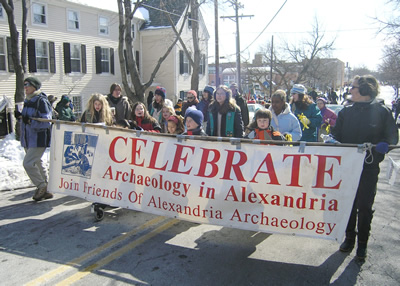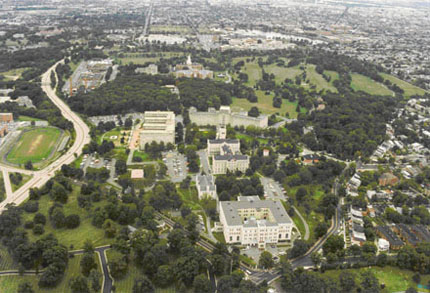
During the 1960s, Washington, DC and its surrounding communities experienced an urban renewal that saw a rebuilding of infrastructure and consequently required the destruction of a number of older buildings in the area. In Alexandria, an independent city a short distance from DC, the destruction of the old buildings uncovered an abundance of historical artifacts that shed light on the history of the area. Realizing that there was a plethora of previously undiscovered, culturally-important artifacts right beneath their feet, the city’s leadership created the Office of Historic Alexandria to try to cultivate and make sense of this new information.
Read more »
Terms:Community Building, Community Engagement, Creative Economy, Cultural Institutions, Heritage, Historic Preservation, IFC Best Practice, Museums, Public-Private Partnerships, Tourism, Washington, DC

The U.S. Armed Forces Retirement Home in Washington, D.C., commonly referred to as the ‘Soldiers’ Home,’ is one of the country’s oldest veterans’ retirement homes and certainly one of the most beautiful. Located on a 273-acre campus in Northwest D.C., the Home’s green pastures and tranquil lakes sit in stark contrast to the developed neighborhoods of the surrounding community. Since the home opened in 1851, the retirement community has been home to thousands of retired elderly and disabled veterans in the Washington area.
Read more »

By Diana Nash of the Pink Line Project on July 12, 2012
There is a buzzword circulating in the DC arts scene that I had not heard about until I returned to the city two months ago. While the concept of using the arts to spur economic and community development is not new, DC is getting attention for the success of its “Arts and Culture Temporiums” since the first one launched along the H Street NE corridor in 2010. Temporiums fall under the larger category of the Temporary Urbanism Initiative, a project undertaken by the DC Office of Planning. The goal behind the initiative, and more specifically, temporiums, is to activate vacant or underutilized spaces by using them to showcase the talent of local artists and other creative entrepreneurs, along with the retail potential that lies within emerging neighborhoods. Think of them as “Pop Ups” that stay around a little longer and have greater potential benefits for the communities where they take place. Jessica Scheuerman, of Partners for Livable Communities, explains that temporiums allow people to “take risks, explore partnerships, and to commit to something” without the burden of a long-term commitment. Temporiums connect creative people seeking affordable space in their neighborhoods with landlords who have the available space that they haven’t been able to lease. It is a smart and increasingly popular concept that lays the groundwork for longer-term collaboration between property owners and neighborhood entrepreneurs.
Building on the success of earlier temporiums, the Office of Planning is targeting four emerging creative neighborhoods to benefit from a $250,000 grant to the city from ArtPlace, an unprecedented new private-public organization. ArtPlace is part of a national “creative place-making” movement that aims to drive revitalization across the country with arts at the center of economic development. The launch of DeanwoodxDesign marks the next step in the OP/ArtPlace grant initiative.
Read more »
Terms:2012, Announcements, Arts & Culture, CBC Press/Media, Community Building, Creative Economy, Culture Builds Communities, Neighborhood Revitalization, Other Events, Public Art, Washington, DC
Walkability is synonymous with less traffic, a higher quality of life, and more vibrant streetscapes. A new Brookings Institution study—Walk this Way: The Economic Promise of Walkable Places in Metropolitan Washington, D.C., by Christopher B. Lienberger and Mariela Alfonzo—highlights the economics behind walkabaility, and why walkable areas are worth more than previously thought.
Read more »
 Here is a section of sidewalk in Boston made from brick pavers. It’s clear that the lack of uniform sizes and heights could pose challenges for the disabled or elderly pedestrian. Photo credit Seldom Scene Photography. Here is a section of sidewalk in Boston made from brick pavers. It’s clear that the lack of uniform sizes and heights could pose challenges for the disabled or elderly pedestrian. Photo credit Seldom Scene Photography.
Designers, planners, and members of the public have recently come into conflict over Boston’s historic use of molded brick in sidewalks and public spaces. Some think the use of bricks represents the face of Boston, while others condemn them as obstacles to the disabled and elderly. The different viewpoints amount to an ownership debate on the city’s public space.
The City’s Commission for Persons with Disabilities maintains that traditional, molded bricks are unable to provide the smooth surfaces (meaning no height variations greater than a quarter of an inch) that the Americans with Disabilities Act requires. However, other professionals (landscape architects, historical preservationists, and the brick industry) affirm that the material itself is not to blame, but rather improper installation and maintenance.
Read more »
Terms:2012, Aging, Arlington County, VA, Boston, MA, City Leaders Institute on Aging in Place, Design, Downtown Development, Fairfax, VA, Historic Preservation, Mobility, Washington, DC
|
|